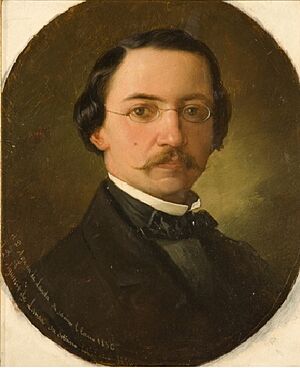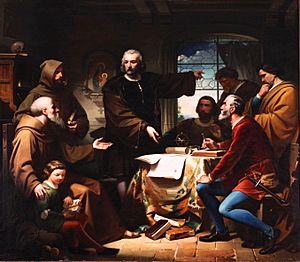Eduardo Cano de la Peña facts for kids
Eduardo Cano de la Peña (born in Madrid in 1823, died in Seville on April 4, 1897) was a Spanish painter. He painted in the Romantic style. This means his art often showed strong feelings and dramatic moments. He was especially good at painting scenes from history.
Early Life and Art Training
Eduardo Cano's father, Melchor Cano, was an architect. In 1826, when Eduardo was young, his family moved to Seville. His father became the city's main architect there.
Eduardo first started studying architecture, just like his father. He went to the Royal School of the Three Noble Arts in Seville. But he soon realized he loved art more. He decided to become an artist instead. He even became an assistant teacher at the school.
After his parents passed away, he moved to Madrid to continue his art studies. He joined the Real Academia de Bellas Artes de San Fernando. There, he learned from famous painters like José and Federico Madrazo, and Carlos Luis de Ribera y Fieve.
Famous Paintings
Later, Eduardo Cano traveled to Paris, France. This is where he created two of his most famous paintings.
One painting was called Cristóbal Colón en el Convento de la Rábida. This painting shows Christopher Columbus at a friary (a type of monastery). It won a gold medal at a big art show in Spain in 1856. Today, you can see it in the Palacio del Senado (Senate Palace).
His second famous painting was Entierro del condestable Don Álvaro de Luna. This painting also won a gold medal at the same art show in 1858. It is now kept in the Museo del Prado, a famous art museum.
Teaching and Later Works
When Eduardo Cano returned to Seville, he became very important in the art world. He was put in charge of the Museum of Fine Arts. He also became a professor of color and composition at the School of Fine Arts.
He loved teaching so much that he spent a lot of his time helping students. Because of this, he painted fewer works himself, about 150 in total. He also oversaw all the repair work at the museum. He represented the museum at important events.
Even though he was known for historical scenes, he also painted other things. He made portraits, like one of the writer Fernán Caballero. He also created paintings in the Costumbrista style, which showed everyday life and customs. He made watercolors, engravings, and illustrations for a magazine called El Museo Universal.
Outside of art, Eduardo Cano was interested in Spanish traditions. He believed that boys and girls should have the same opportunities for education. He was also a talented musician.
See also
In Spanish: Eduardo Cano de la Peña para niños



